City of Experiences
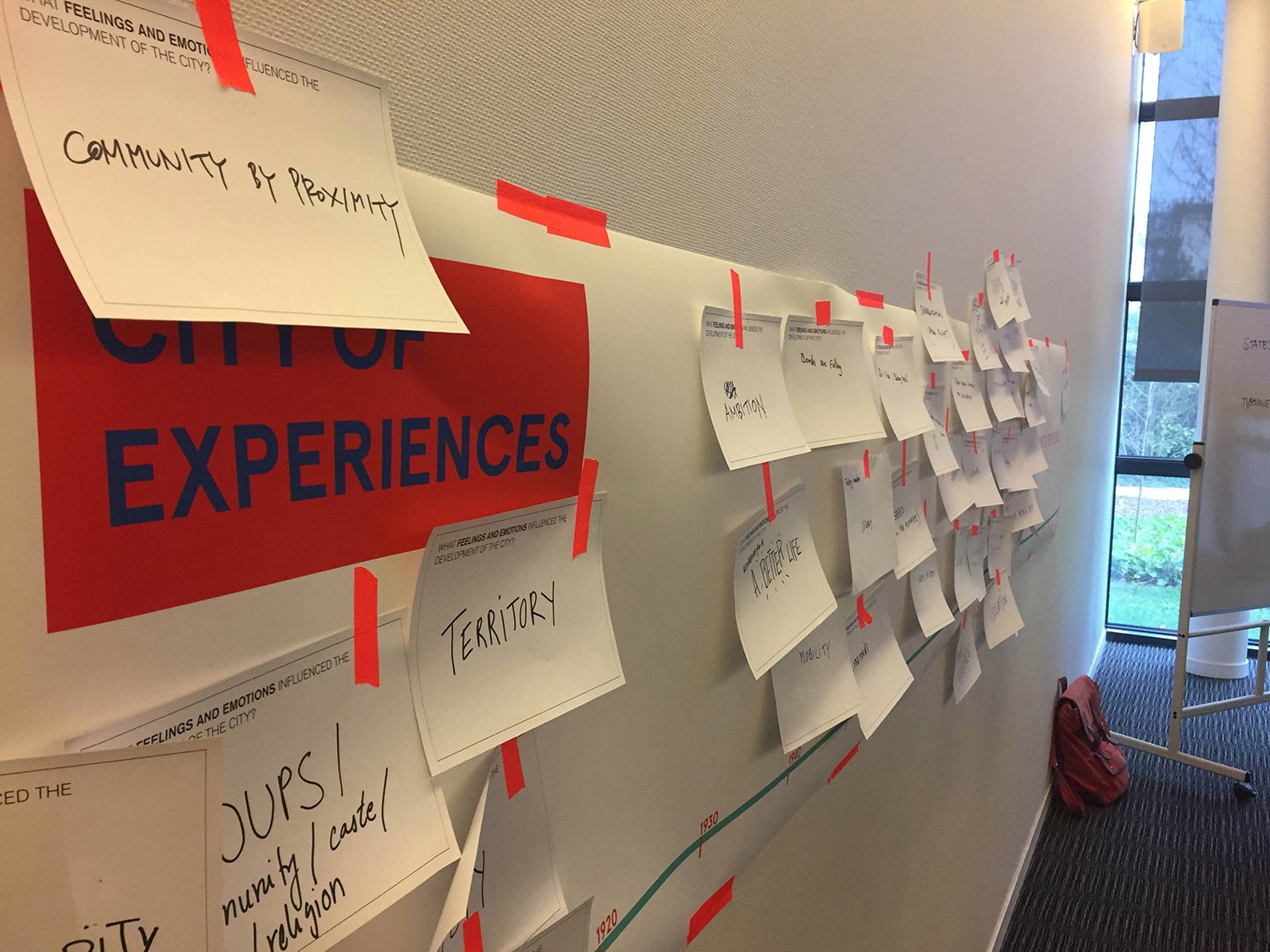



💭 Project Description
Our contemporary reality is shared between the digital and the physical. Surpassing standardized development models of the 20th century, we have entered the 21st—a 50% digital/50% physical fluid presence. Currently, daily urban interactions are designed top-down and pre-planned by external forces. As the landscape evolves, humans have more opportunities to intersect with physical and digital realms as they navigate the city and its experiences, creating a series of micro-interactions that occur across and throughout urban spaces. Our society is faced with the issue of adapting and understanding the ideologies, structures and systems involved in this new way of living, modifying the definition of cities to encompass experiences that extend beyond just the physical infrastructure. We ask, in an era split between physicality and technology, how can the city be designed through the lens of human experiences?
First initiated as a workshop presented at the 2018 IXDA Education Summit, DoUC facilitated a creative and collaborative program that explored city building through an experience-based lens. Beginning the workshop with a timelining exercise, participants mapped out 118 years of a (real or imagined) city’s history—identifying the associated feelings and emotions. The workshop then considered the products, systems and services that influenced the development of the city, visualizing the complexity and multi-scale relationships between them. Finally, working in groups, participants developed a concept and prototype for their own new product, system or service. The workshop aimed to encourage a different way of approaching interaction, policy and city building in order to push for the creation of more adaptive services and relationships within future cities. The intention of creating policy that integrates and embraces these new layers of interactions is not to enforce micro-regulation of micro-interactions, but instead to treat the city as a space of greater potential to support and facilitate new people-to-people and people-to-object interactions.
Beyond the initial workshop, City of Experiences (CoE) has evolved into a project repertoire that examines the relationships between objects, surfaces and experiences—shifting from the design of the physical to the experiential. Each CoE project aims to gain new understandings of the world around us, share experiences and empower transformation in new and interesting ways. CoE has been explored in the form of workshops, lectures and exhibitions —reframing the way cities are designed by imagining what it is like living in the city of experiences. DoUC’s City of Total Awareness project is linked to the idea of the City of Experiences, visualizing both obvious and hidden physical infrastructures and digital networks in the GTA and prompting people to question their future behaviours based on access to data. The designing privacy panel discussion (in collaboration with Pantopicon) addressed the designers’ role in digital privacy and how this can be explored and practiced in order to build more agency over online experiences, and led to the development of a privacy framework that guides how to think about consent and regulation.
As well, DoUC has developed a series of technology-merged City Objects that serve a purpose beyond their normal usages and act as relics of enhanced experiences—designed as both physical and technological tools: a prototype augmented reality (AR) application that is integrated with a food pantry’s community garden in Sutton (Ontario), an art bike with AR functionality to express the emotional journey of riding a bicycle, and a 24 hour AR clock that creates personal narratives and visually connects memories and data to encourage self-reflection. With City Objects, we aim to explore the ways in which city dwellers can leverage new technologies to share experiences, express emotions and reflect on personal and shared histories in a human-centred way, while retaining the original function of the objects.
Overall, City of Experiences aims to re-shape the way cities are designed by continuing to challenge how urban environments are constructed and who they are constructed for. Emotions and experiences are often overlooked by the formal planning process due to lack of tools needed for designing policies that can better incorporate them. Having identified the critical relationship between people, tools and space—City of Experiences intends to provide city residents with the necessary tools for designing their own environments based off shared needs, emotions and experiences.
The project team included: Christopher Pandolfi, Elise Hodson, Izzy, Robert Giusti, Sam McGarva, Shaili Chibba, and more contributors over the years.

A poster for the City of Experiences Mastercraft class at the Design Exchange (Feb 2019)
Take a look at some of our other interviews around the City Objects projects…
The Evolution of Bike Share
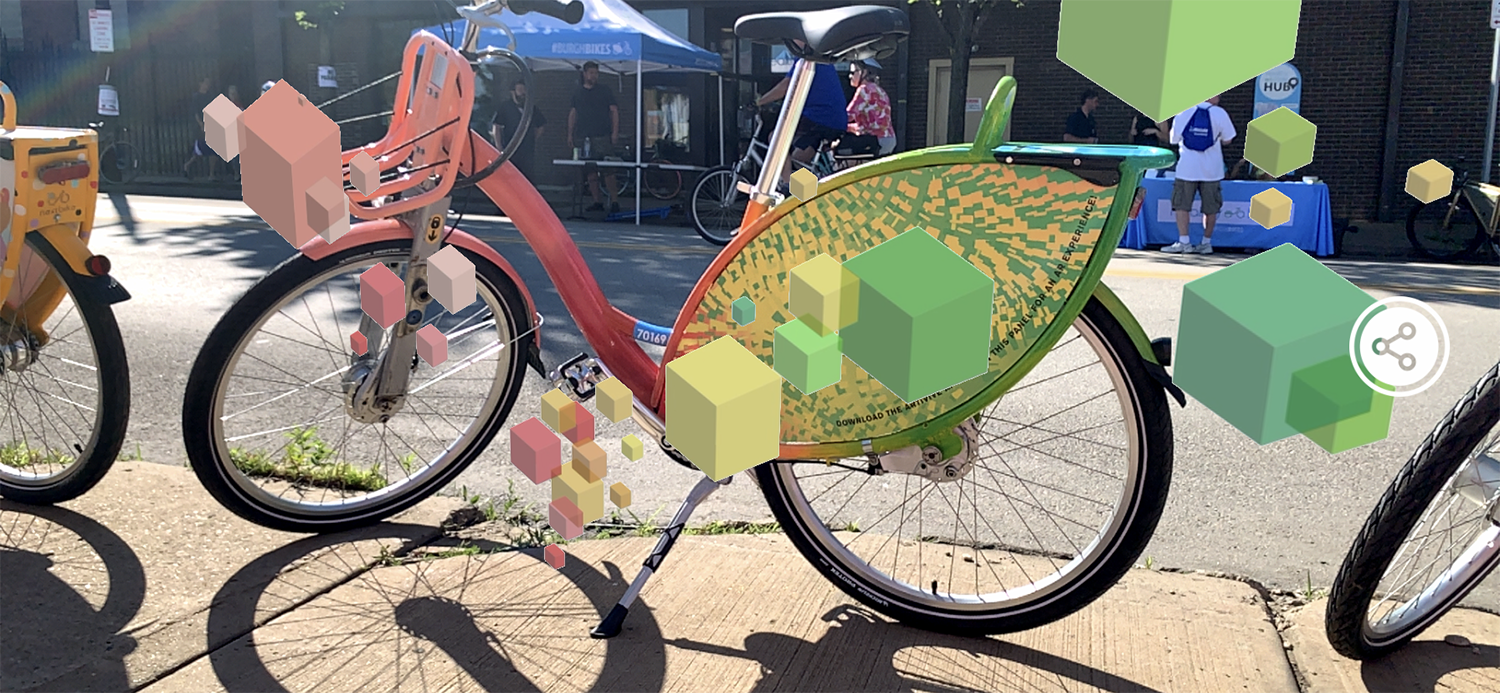
devices_for_self_reflection_001
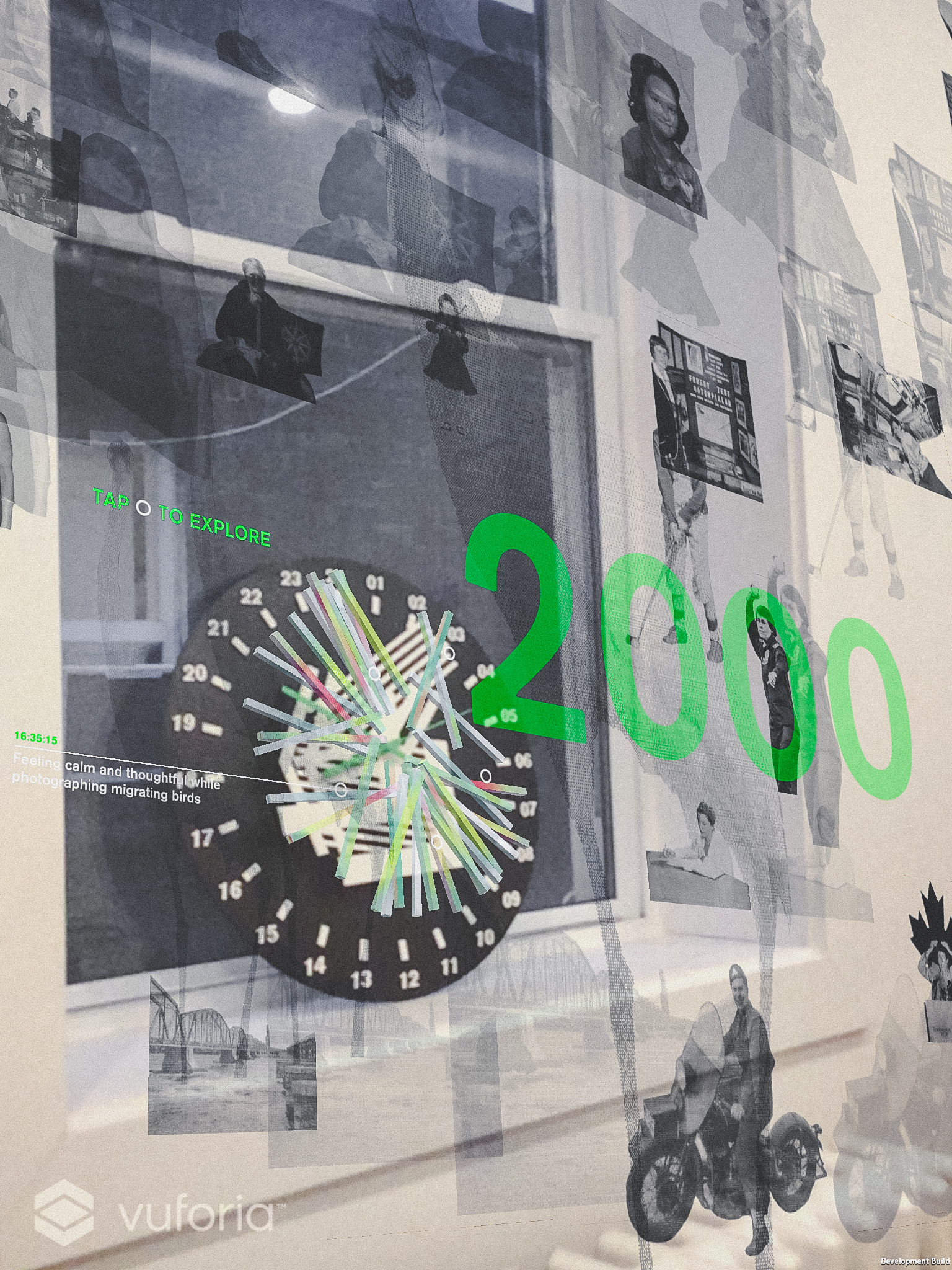
To commemorate DoUC’s 10 year anniversary, we have organized an interview series highlighting past DoUC projects.
We wanted to take this milestone opportunity to revisit projects in a fun and reflective way, calling on the perspectives of both past and present DoUC team members. Shifting from objective and brief project descriptions, we revisited our work with a renewed intimacy. With more personality. We hope this series provides deeper insight and understanding to past projects. Or, is simply a fun read!
To help you navigate this series, we recommend first reading the project description for context. Then, you can explore the interview dialogue. Enjoy! 🙃
ℹ️ The City of Experience interview was conducted with Chris Pandolfi (CP), Elise Hodson (EH), Izzy (IZ), Robert Giusti (RG), Sam McGarva (SM), and Shaili Chibba (SC).
So, this project is more like an umbrella project, but it doesn’t seem to have started that way. From your perspective, what inspired this idea? Why did you feel like it was worth pursuing?
CP ⤳ I think it’s important to understand that DoUC has always been a place that is exploring the world or worlds that are constantly being created/destroyed/reimagined. City of Experiences is actually a culmination of many of these explorations. It is about constantly thinking about the way we live and how that life is evolving. I want to be clear that when I say evolving I do not mean this necessarily as a positive attribute, more so from the perspective that this is happening or this happened and this is now what that means. At DoUC we have been looking at the city since we started. The city as a place where systems are acted out not in the abstract, but in practice. I think this is important for us because as a studio we never like to stay in the abstract for too long and begin to imagine with others what we are exploring and think about ways we can create different types of actions. When we first thought of the idea of City of Experiences the idea itself came from another project where I was working with people on a specific issue of how to better think of creating a more sustainable hyper local food system, that would connect to the larger systems. The idea for city experiences started. The main idea begins with what if we could design cities from an experiential point of view rather than a physical understanding of products, systems and services so often pushed in city design – physical manifestations that drive emotional understanding. This has also started us on a path to build alternative tools we could use with people to help build out this concept. Finally we started to look at our past projects and began to understand that the components we were beginning to explore were already present in our past projects.
RG ⤳ I remember having a conversation with Chris about this prior to running a workshop in Lyon at Interaction 18. It started with a conversation about Italo Calvino’s Invisible Cities and the twin narratives that he elegantly constructs where cities of imagination interact with cities and experiences of reality. Woven through the city are narratives of culture, language, time, memory and death. The idea of these twin cities – imaginative and real – can now manifest via digital and physical means. Yet, we have not spent nearly enough time understanding and crafting how this growing digital layer impacts our interactions and experiences – what harms it might bring and what benefits it might unlock. In this sense, there are fundamental opportunities to establish a new design language for the urban realm – one that interfaces material and immaterial.
SC ⤳ I wasn’t there when this idea was first initiated, but I think that it’s very much worth pursuing. If anything, it’s a fantastic thought-experiment that challenges the construct of our established experiences. And, who’s to say that what we have is what is best? So, in a way, this is a fundamental design question— how can we do better? Something we should constantly check in on.
IZ ⤳ I feel as though the idea had its beginnings in IwB’s Future Ways of Living, or rather this is what FWoL could have been. I felt that the project was worth pursuing because I wanted to explore the idea that we are “living in the 50/50 (some might say 80/20), a fluid presence between the virtual and physical worlds” –which was part of the curatorial statement of the exhibit. I believe this to be pertinent, now more than ever, as we’ve been working and collaborating virtually from home over the last few months due to the COVID-19 pandemic.
EH ⤳ DoUC has been doing interesting work on this topic in a number of formats and from different angles. Bringing these projects together under the title of City of Experiences makes sense because it draws attention to the urban and the human – the technology is implicated but not the focus. Chris and Sam were able to bring CoE into the classroom in the Interaction Design program at George Brown, where I worked, and it really inspired the students. Their final projects were amazing! And very well received at the year end show. I became more involved when the institution formerly known as the Design Exchange invited the college to create an exhibition with some of that work. At which point, we got students Shaili and Izzy involved to work their curatorial magic.
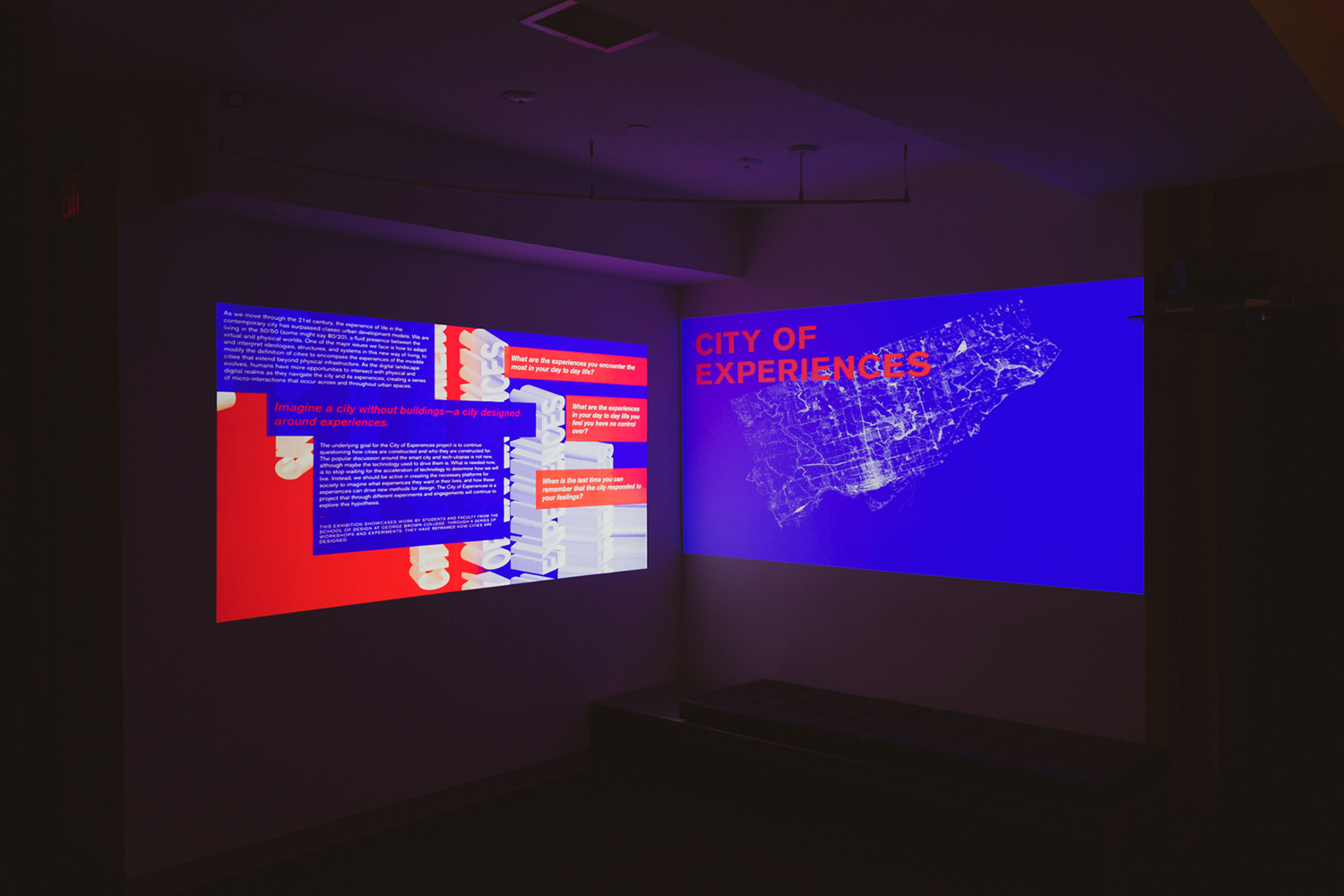
City of Experiences exhibit at the Design Exchange (Dec 2018 – Feb 2019)
In your understanding, what was meant by the original question proposed with this project: We ask, in an era split between physicality and technology, how can city objects be designed through the lense of human experiences?
EH ⤳ I think this question was really highlighting that ‘split,’ the division that exists between built environment and new technology, between existing physical infrastructure and traditional ways of planning and the more recent and emerging layers of digital technologies. The question reminds us that cities are for people and suggests that the human experience should be the driving force behind how those layers can come together in new ways.
SM ⤳ I thought of this project as asking about the convergence of the two rather than a split—what would it mean to lose the idea of “reimagining cities from the internet up” and shake the constraints of designing for the digital and physical as two separate experiences? What are the moments of transition and what are the moments we move in both?
SC ⤳ I think that we live in cities often designed around the objects themselves, instead of the people who are going to be using them. For example, sidewalks are fairly small in Toronto because our roads are designed to accommodate multiple car lanes— which really means that being a pedestrian and engaging in the city as a sort of flaneur isn’t quite encouraged. Now that’s just one example, and we can go on and on about more of them, but really it’s about how we can take a look at the city and the things within it starting by considering the people who are going to live there.
I believe that is where the real opportunity lies; to use all of the tools at our disposal in order to make experiences that truly connect with and engage people in a way that connects and engages their city. Also— there’s also something to be said here about how this approach fosters a sense of relationship between the individual identity and the identity of the city.
IZ ⤳ The design of cities have evolved to accommodate our capitalist needs since the industrial revolution, and in turn, grid plans, skyscrapers, subways and highways have also shaped how we experience the cities we live in. As we deindustrialize, moving away from primary/secondary industries, and towards tertiary/quaternary industries, we need to acknowledge and understand that designing interventions not only accommodates new possibilities, but creates new realities for us to experience.
RG ⤳ A human experience can be extremely abstract, and often described as interactions that evoke emotions, fulfill a fundamental human need or facilitate exchange. In this sense, experiences can be evoked through both physical and digital interactions. They are both real in the sense that they exist, but in different forms and materials. The question being posed is one that encourages the designer to imagine new forms of interoperability between these mediums to enhance or augment experiences within the broader urban realm.
“I think there has been this idea for a long time that there are these two worlds that exist and you’re living separate lives in them, and that isn’t the case. There’s this one world we live in and experience both of these things simultaneously. There’s spaces we build community in, spaces that we shop in, spaces that we acquire knowledge in.”
Explored in this project is the idea of a 50/50 split between the digital and physical worlds in our cities. Can you explain this idea in more detail? Do you imagine this being for North American or Western cities in particular?
IZ ⤳ The split between digital and physical is prevalent now more than ever, especially due to the COVID-19 pandemic. Most of us had to transition from being part of a commuter workforce to a sedentary workforce almost overnight. Most of us are spending more and more time in front of screens and online to be productive, or collaborate with our peers, or order necessities for delivery —without risking social interaction.
I don’t believe that it’s only in North American or Western cities, thanks to globalization the same technologies we have access to in the West are enabling digital leapfrogging in traditionally impoverished parts of the world. In some cases communities in the Global South have adapted much more efficiently to the virtualization of services than the west.
I think this has laid bare everywhere the class inequalities that are normalized, and necessary for a capitalist society.
RG ⤳ I’m currently living in Dublin, so let’s contextualize it in this space. Since March, I’ve been in various states of restricted movement and been forced to work from home, a new standard that is quite global. I spend between 7-8hrs a day during the week on my computer, immersed in a digital space that enables me to document & communicate my ideas, connect with colleagues, consume literature from across the globe, and stream music from a nearby smart device via airplay. When I’m done working I might go for a run, and connected devices track my distance, heart-rate, average time/km and upon completion I can compare my stats with other people that have run the same route. I stop to grab dinner on the way home and use my phone to authenticate a payment. It sends me an immediate pop-up to document my transaction and updates my balance instantaneously. These daily experiences are not uncommon, and it is through this lens, and the increasing permeability that our infrastructure is becoming increasingly divided between physical and digital. The difference is that the digital infrastructure is less visible. Just as a physical object has an address, digitally we can provide addresses to every object, human, interaction and relationship. Programming these relationships and addresses have yet to be fully realized to unlock new capabilities, which requires creative composition across scale and temporality.
SC ⤳ I think that this is something which can be applied to any city in the world. Many developing nations have “skipped” over certain parts of industrialization that Western nations went through and are developing infrastructure that is actually even more advanced than what exists here. So, why not.
Also, I don’t think it’s really possible to move forward in a progressive manner anymore without considering a marriage between the digital and the physical. To be clear, what I mean here is that technology is a tool, and we must use the tools at our disposal in the best possible way to facilitate collective growth. Whether this is to support basic warning systems, traffic systems, public transportation, accessibility, housing, travel and tourism, whatever— there is much opportunity for the digital to work with the physical.
Take Singapore’s Intelligent Traffic System for example, which measures many factors to alleviate congestion and maximize the capacity of their transportation network. One of them in particular is the Electronic Road Pricing System that tolls drivers according to traffic flows and uses a short-range radio communication to deduct charges from smart cards embedded in the vehicles. No need to stop and pay, no unnecessary congestion.
CP ⤳ I think there has been this idea for a long time that there are these two worlds that exist and you’re living separate lives in them, and that isn’t the case. There’s this one world we live in and experience both of these things simultaneously. There’s spaces we build community in, spaces that we shop in, spaces that we acquire knowledge in. People talk about how you have an identity. It’s important that when we’re thinking about experiences we’re ensuring people understand these things are happening in one life, even if you have different identities in different spaces. There are becoming more opportunities for you to define yourself and your identities and express those across new and different spaces.
EH ⤳ I can’t remember the origins of this 50/50 percentage, but smart cities and the increasing reliance on the digital, whether it’s city infrastructure or personal devices, isn’t limited to N.A. but certainly there are local and regional differences. Answering these questions from Helsinki, I can say that the split is far less obvious than in Toronto in the sense that city services are digitized and integrated here. It is essentially a cashless economy and the private and public sectors are inseparable from a citizen perspective – healthcare, transportation and other services are accessed through phone/data, bank and mobile i.d.
What would you say is the split between the digital and physical worlds in your life? Do you want this to change in any way— how?
EH ⤳ I am always surprised by the weekly screen reports. Am I really staring at my computer and phone that much? I’m not sure it’s a 50/50 split. What if it’s 70/30 and that 30 is when I’m sleeping? I am tired of scrolling.
CP ⤳ The blending of physical and digital keeps increasing, you can’t easily tell the difference anymore and we’re not conscious of how seamless these transitions have become.
Prior to Covid, there were certain communities or parts of my social life where maybe I would have communicated with people in very passive ways, not in any meaningful ways. My communities weren’t really in a digital space, I’ve always had a bit of a problem relating to digital communities and don’t have a way to commit to them in that way. When I think about other functional parts of my life, when I move beyond social aspects into work, I’m essentially a digital creator and most of my work is recorded or documented in digital space. We design things in digital space–worksheets, activities, etc–but they are often used in physical spaces. Most of my life on a daily basis is spent in a digital environment, moreso than I’d like to think. I want to think we do more physical things, but as the studio has progressed our time is increasingly spent in digital environments. You don’t think about the seamlessness in which you transition between these things, moving from a whiteboard sketch to designing something in….undocumented transitions, it just happens —
The city should be built with and for the living world.
If the city is going to evolve, so should the process for designing cities
Local communities should have the power to decide what is best for your community, but at the larger scale systems and services should be providing ways for you to get those things you need.
SC ⤳ With Covid-19 it’s definitely become skewed significantly towards the digital! Which I really do want to change, but can’t due to necessity. If it’s about 95 digital and 5 physical now, I would say that pre-Covid it was around 70-30. Not too bad. I would love to get anywhere close to that again! Really missing real three-dimensional human to human time.
IZ ⤳ There isn’t a split. Our devices have off-switches that are seldom used. If one device is shut off, or put aside it’s because another one is currently being used. Furthermore, the curation of an “authentic” omni-present virtual presence is necessary to build trust on social networks and online communities.
I would want this to change because as someone who values their privacy and especially anonymity, I find these cultural norms to be exhausting.
RG ⤳ It’s hard to say where the line is drawn between the two. I don’t envision it as a split, but rather as a merger, and that merger seems to be inching closer and closer to 100%. I don’t necessarily want to change this, but we need to think about the fundamental human rights associated with the merger of these two worlds. The east is already giving us a sense of the utopian uncanny valley that can manifest when our digital presence begins generating user identities whether we’ve consented to them or not. That is not a world I want to live in. One benefit of the City of Experiences is that in imagining future scenarios, you might also be forced to uncover unintended consequences, which can drive conversations about ethics, policy and intentionality.
When you first presented this project at the 2018 IXDA Education Summit in the form of a workshop, how was the response?
RG ⤳ People genuinely want to contribute to the idea and help push it forward. There was a lot of positive feedback and excitement around the narrative, but people also want tangible frameworks to contribute to the City of Experience.
CP ⤳ People found it really interesting to think about the feelings and emotions first. At first they were a little uncertain, and needed us to explain in more detail how to think first about the events and then imagine the emotions and experiences attached to them that are driving the events. This is what we’ve noticed for all the workshops. The idea of asking people to do this is very alien to them, however once they get started it’s the easiest thing they’ve ever done and it becomes very fluid. It’s like a trigger. One person said to me “Not all people live in cities”, which is true, but what’s really important to think about is that City of Experiences is really just using the city as a code for where humans live.
Did you get a sense that the participants explored/found “new way[s] of approaching interaction, policy and city building in order to push for the creation of more adaptive services and relationships within future cities?” Give us some examples of these new ways if you remember them!
RG ⤳ The workshop we ran was a bit more high-level and we didn’t have an opportunity to get into detailed ideas/concepts. Rather, it introduced participants to the idea of the City of Experiences and encouraged them to create a temporal map of the products, services and experiences that have influenced/shaped their mental map of the city. Using that mental map we layered the different emotions, desires and feelings that defined individual experiences and used that as a point of departure for what the emerging urban fabric might embody.
CP ⤳ I think the one thing that we found which was across the board is that when participants are asked to think about the key emotions or (at a more granular level) the feeling of the specific events they were mapping, they began to think differently of what it means to make a decision and more importantly how many of these events both large and small never really took into consideration the experience people would have and how most of our large systems were not really designed for actual people, but more so the organization of people to match the goals of power structures. This is really important because the ideas that come later on are embedded with different values right at the start. It allows people to listen and to work together on ideas that would represent these different values.
EH ⤳ The student projects weren’t limited by any consideration for policy, regulation or bureaucracy, but were really driven by content and experience. One project transformed Nathan Phillips Square into a giant interactive light show/dance floor.
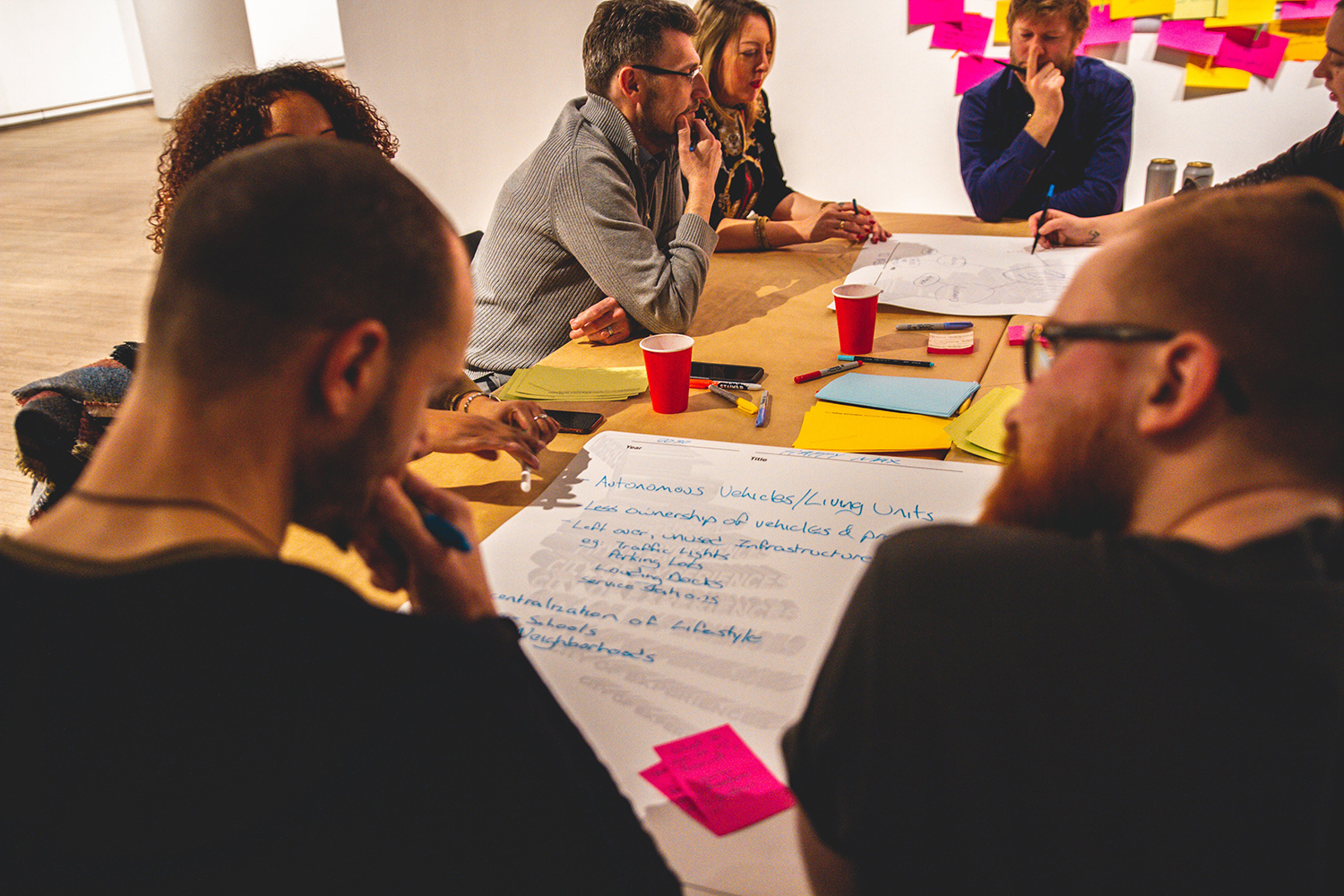
Workshop participants at the Design Exchange (Feb 2019)
Considering the kind of time we’re living in now, Covid-19 and all of the system failures it is exposing— what kinds of new ways of approaching interaction, policy, and city building would you propose off the top of your head? If you have any people or organizations who are already doing this that you think are worth highlighting, let us know! Tell us why you think these approaches are important.
SC ⤳ One of the key things the pandemic revealed to me was how everything that changed was actually already “normal” for many folks. Not being able to go outside, barriers of engagement, sense of isolation and other anxieties, including a constant sense of “dread,” and so much more. And so, the speed at which companies and organizations facilitated remote, at-home, and digital engagements— when it was something that many (dis)abled folks have been asking for so long, was simply embarrassing.
So, with that said, I don’t think that this is a new approach at all, but one that we should always start with regardless of what we are doing— if we design systems with the most vulnerable in mind, we will inevitably reach the largest number of people possible.
IZ ⤳ We need a socialist approach to interaction and policy. I feel there’s a huge crisis of leadership because collectively we still haven’t come to terms with the failures of neoliberal economic policies, or the negative impacts it has had on our communities and the environment.
RG ⤳ Don Norman & Jan Stappers hosted a conference in 2014 that they called ‘DesignX’. In this conference they explored problems that don’t stem from a lack of understanding or willingness to address issues, but rather those that arise during implementation – social, political, economic, cultural, organizational problems that fundamentally impede successful systems change. Designers need frameworks and tools that help deconstruct these complex interactions and design for them. We also need a better understanding of the underlying digital infrastructure, logic and limitations that either enable or impede the interoperability, authentication and interaction between different elements of the city.
CP ⤳ I think FoodShare is a great organization because it showcases how a strong value system working at multiple skills can create different scales of impact simultaneously. In one moment- they are fighting for better policy around the right to food, while simultaneously building local infrastructure to showcase what this policy looks like in practice.
“People have a really difficult time imagining unintended consequences, and unfortunately economic shortsightedness is still a driver of decision making – even in the public realm.”
In your opinion, what are some of the major barriers to creating new policies that “treat the city as a space of greater potential to support and facilitate new people-to-people and people-to-object interactions?”
IZ ⤳ The bureaucratization of civic engagement.
RG ⤳ Foresight & value. People have a really difficult time imagining unintended consequences, and unfortunately economic shortsightedness is still a driver of decision making – even in the public realm. There has been a lot of dialogue about anticipatory policy, to get ahead of technologies like facial recognition, usage of drones for mass surveillance, algorithmic decision making, but even those conversations are reactive in my opinion. We haven’t figured out the right approaches to deal with the speed of technological change, but we are beginning to see mechanisms beyond government that help ensure our shared societal values & human rights are upheld as we develop new experiences.
CP ⤳ I think the problem is that city building itself is built on this premise of taking care of the physical things first and then understanding how the social fits into that. Now you’ve added digital spaces and digital interactions and systems that are part of residents experiencing the city, but also they contribute to the government making decisions about the city and about the city-building process. But there has been no attempt to understand how we communicate or manage this big evolution of the city to the residents of the actual city. There’s been engagements but they’re the same as they’ve always used, the process has not inherently changed. The thing that really needs to change is we need to start taking how people feel more seriously, and documenting peoples’ experiences as actual research that can be used to build policy.
The major barriers, whether the city is about being a smart city or a purely physical city, it’s always the same….people’s lived experiences need to be listened to and then there needs to be action taken on them. The true barrier is that right now there is listening to peoples’ experiences but it doesn’t translate to action by policymakers.
SC ⤳ Hmmm… possibly nimbyism and plain ol’ bureaucracy. Perhaps if more people were open to sharing their neighbourhood space we’d build more interesting overlaps between different communities. I think this is something that requires the people of a city to have a shared collective identity— which, in a fairly heterogeneous city such as Toronto can be difficult to pin down. So, maybe we start with a bit of both 🙂 For some inspiration, I recommend checking out the subReddit r/yimby for people championing some great things they’d love to say yes to in their backyard.
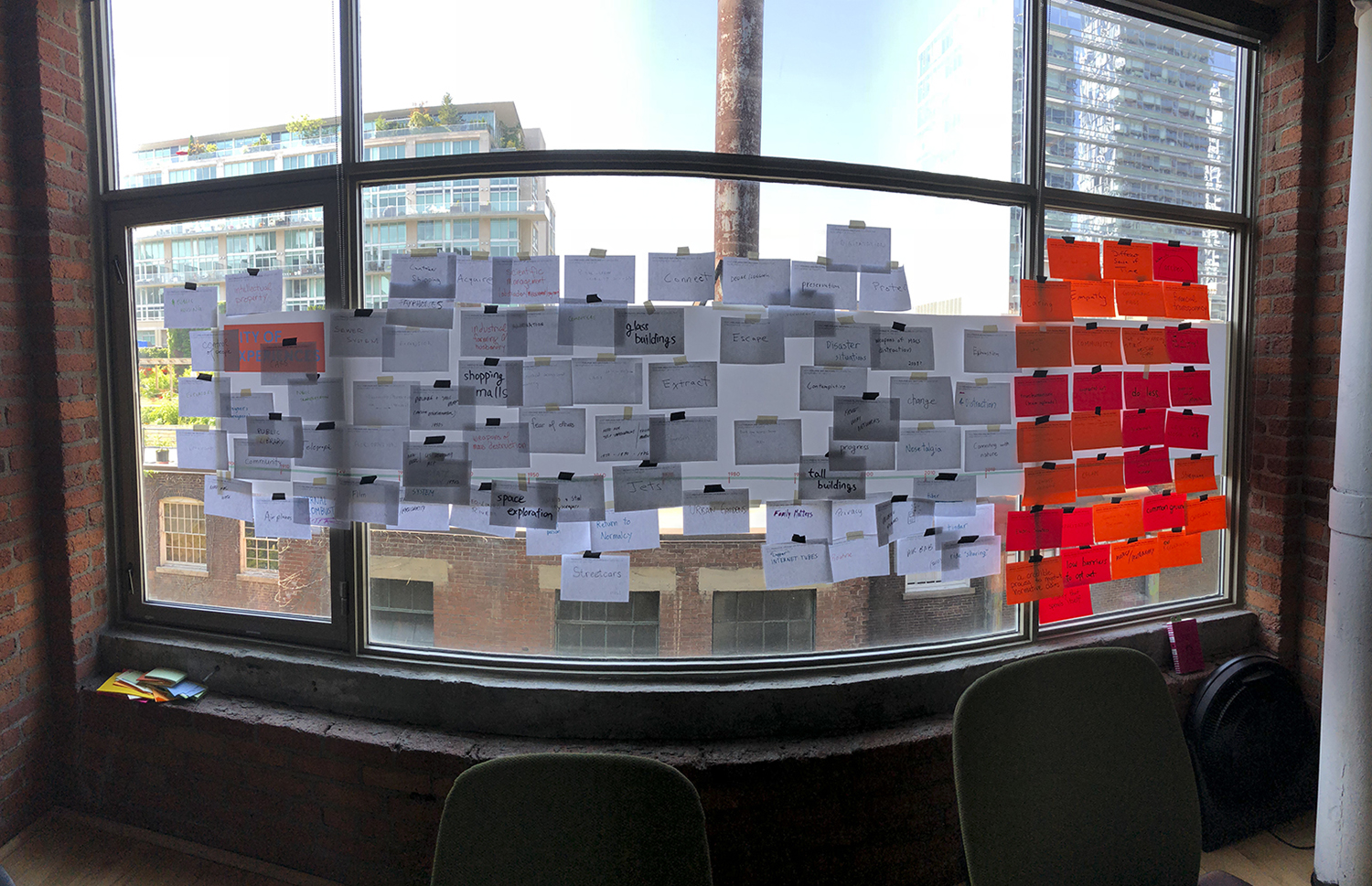
Tell us about some new people-to-people and people-to-object interactions that you would like to see in your city.
CP ⤳ staying away from this 😉
RG ⤳ Yeesh… You guys ask all the tough questions.
Moving to a new city last year was not as easy as I’d expected, and despite COVID 19 it’s something I envision doing many more times in my life. I’d really like to see more universal interactions that enable a fluid transition between environments. That might mean adaptable user interfaces that understand my preferences upon arrival and ensure interoperability with new local services, or new ways of convening and interacting with the community via shared experiences that are activated via place and object.
IZ ⤳ In Toronto, we need to do more to foster inter-community relationships. Our neighbourhoods are naturally divided along nationalistic divisions, and I would like to see more being done to promote cultural exchanges across community borders.
SC ⤳ After Covid? More easily accessible and often celebrated little community events everywhere that encourage pedestrian exploration and interaction.
As the project began to expand and include a family of explorations— did you imagine it taking this route? How do you feel about it going this way?
SM ⤳ At the start, it was just a single workshop, so I never imagined it being as broad as it is! I’ve loved all the work and the thought and the competing perspectives that have been showcased through this project.
SC ⤳ Last we explored the AR Bike and AR Clock— and nope! Did not expect it to take this turn, but Chris’s mind is a bit of a mystery and there’s always really interesting pathways that he takes projects on that I am happy to explore!
IZ ⤳ I did not expect the project to expand and include such a wide breadth of explorations. However, I feel that it’s in the nature of complex systems to produce more complexity.
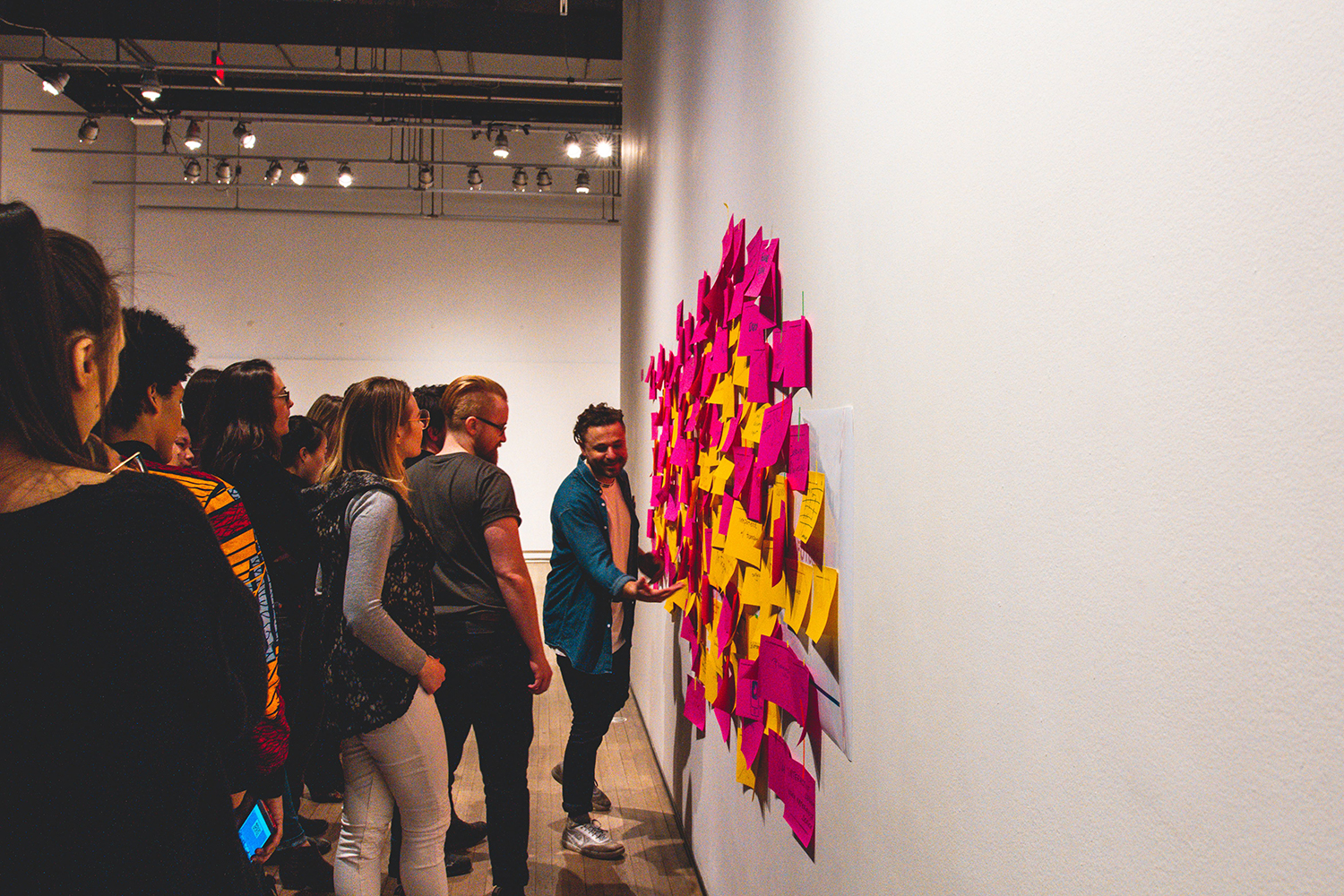
CoE Mastercraft Class at the DX (Feb 2019)
“The public events are important for helping people imagine what else is possible.”
In your perspective, why has it taken the forms it has: workshops, lectures, and exhibitions? What are some other forms you hope it will take in the future?
SM ⤳ I think DoUC projects are generally scalable because at the heart of each is a research question. Each new form a project takes on is attempting to pose or answer that question in a different context.
CP ⤳ I think the forms it has taken matched where we are with our thinking— exploring and experimenting. I would love for the next phase of this project to begin to start to work toward actual actions and community development. I think we are on that path now.
SC ⤳ Workshops, lectures, and exhibitions are some of the best ways to expose a variety of people to a new topic, different way of thinking, and hopefully inspire some thoughtful discussion. Each person is going to approach the topic in their own way, bringing their own lens, their own life to the interpretation, and that matters. A city is, after all, a shared experience that unfolds in unexpected multitudes. As a studio proposing this exploration we are always interested in what each person has to share and are always delighted to be privileged with these stories.
Maybe it could become a real “town-hall” exercise in the future, whereby each community in the city engages its citizens on a yearly basis to understand experiences and propose new and better ones!
RG ⤳ It’s taken the form of experiences. In delivering it through these mediums, it is establishing a city of experiences in its wake. I’d love to see more prototyping sessions where ideas are made tangible and embedded into the environments in which they’re envisioned to garner feedback & observe human behaviour.
EH ⤳ The public events are important for helping people imagine what else is possible. The small, applied projects are needed as demonstrations and tests in unconventional settings to push thinking, like using AR in the community garden in Sutton. It would be interesting to do a project with the City of Toronto, where DoUC is embedded within a planning team.
IZ ⤳ The process of mapping this type of complexity needs to done across multiple formats, mediums, and modes of communication to promote engagement, accessibility, understanding, and action. I’m hoping that in the future we’re able to engage with academics and audiences from other cities and countries. It would be great to engage with and foster relationships with diverse communities in other urbanized areas of the world.
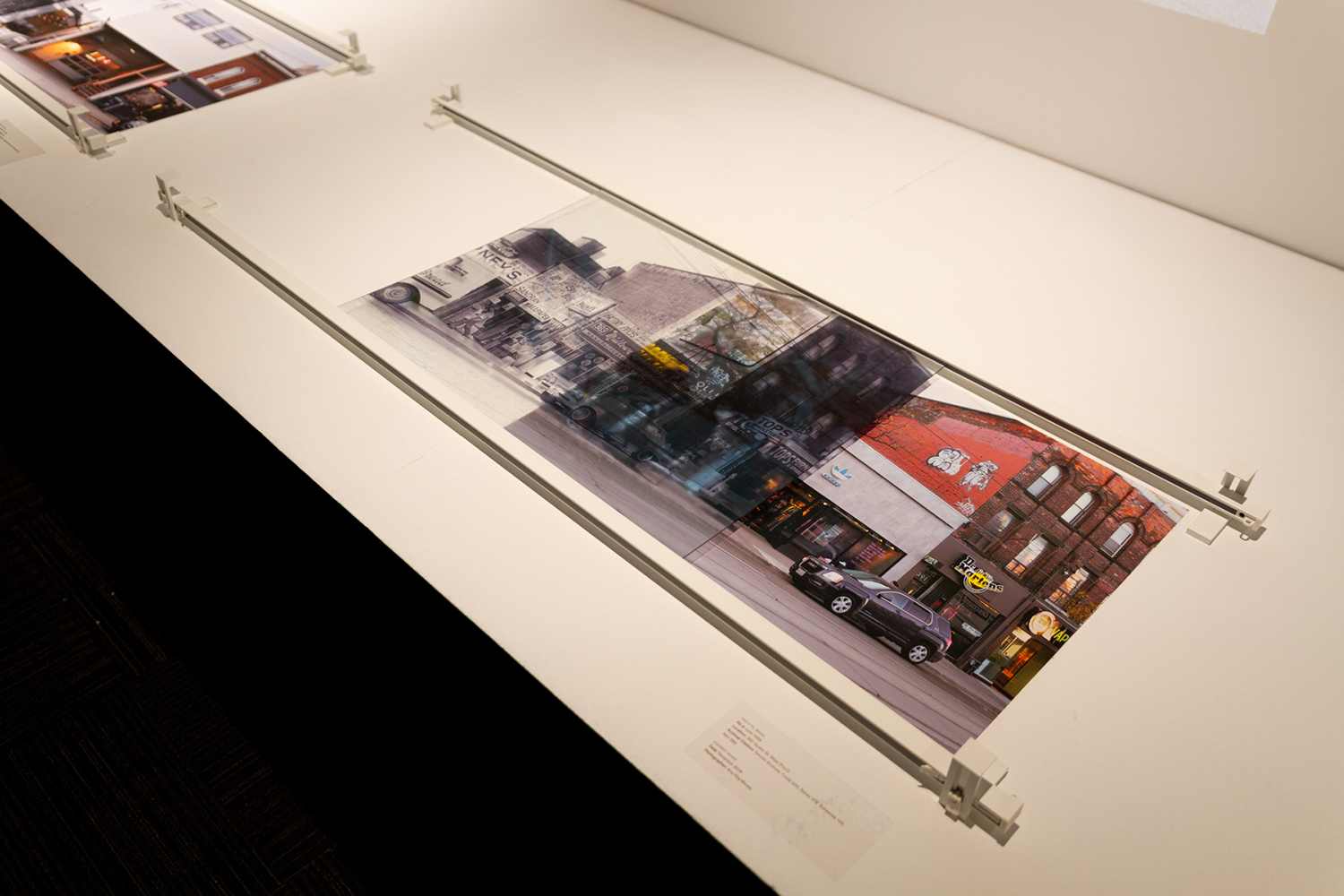
me-dérive: toronto by Dr. Ana Rita Morais at the CoE exhibit at the DX (Dec 2018 – Feb 2019)
In your project description on the website, you state that “each CoE project aims to gain new understandings of the world around us, share experiences and empower transformation in new and interesting ways”— do you have a favourite by any chance? What are some interesting understandings that you took away from it?
IZ ⤳ Shouldn’t a curator try to be impartial about the projects they’ve included in an exhibition? That being said, my personal favourite would be me-dérive: toronto. It demonstrated very succinctly and efficiently that the past shapes our present, and our future. The project used the latest technologies, as well as simple sliding translucent overlays to convey this.
SC ⤳ Ohhh hmmm, I would say that the overall CoE exploration that Chris and Sam conducted with the IDD class of 2018 was my favourite. I was not a part of DoUC at the time, but the project was still in many ways a part of the studio. In my group with Izzy and Luke in our graduating class, we explored the relationship of innovation between fiction and reality within the lens of science fiction. It was so informative and fun understanding the ebbs and flows in human imagination and realization— especially considering how many things we now use on a daily basis were somewhat proposed hundreds of years ago by writers, which then were imagined individually by readers, and then collectively experienced by film viewers before they eventually made it into our pockets and hands.
Have these understandings impacted world-view or even your daily life in any way?
EH ⤳ It helped me to think about how technology can facilitate shared experiences in public space without relying on individuals’ devices, networks, etc. and to think about the potential for interactivity as part of basic infrastructure.
IZ ⤳ Yes. I’m much more conscious of the work I produce, and the types of interactions I have with others because I know that it has the potential to impact future possibilities.
RG ⤳ Being exposed to this project and other similar projects that the Department of Unusual Certainties have spearheaded over the past several years (i.e. the City of Total Awareness), have made me more conscious of the digital stack & infrastructure that enables many of our current interactions & experiences.
SC ⤳ Really just reinforcing the idea that we are “standing on the shoulders of giants.” It is important to remember and understand our past, in order to continue to move forward in a progressive way.
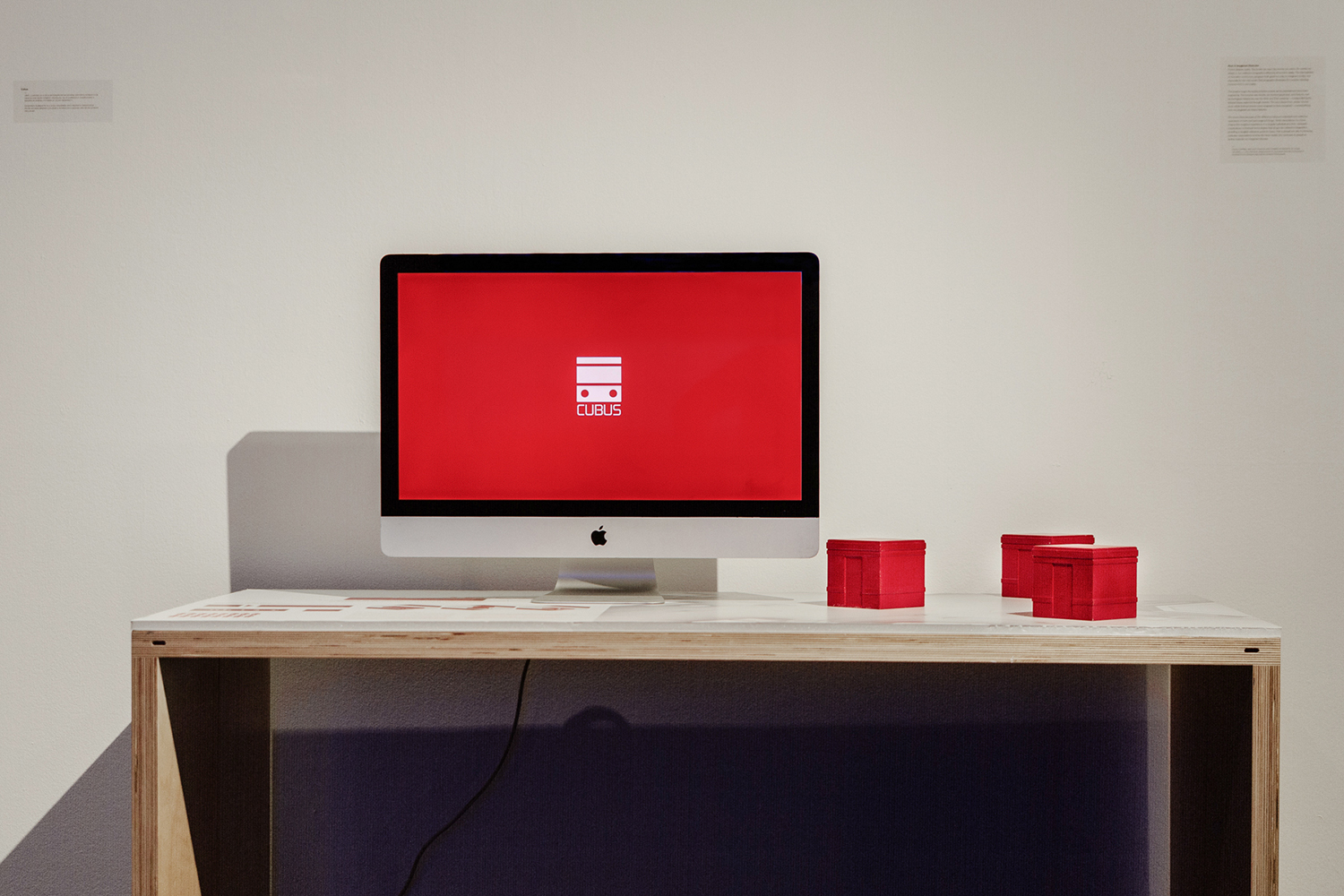
Cubus, a GBC student project featured at the CoE exhibit at the DX (2018-2019)
In your opinion, what are some interesting emerging technologies that you think
“city dwellers [will] leverage to share experiences, express emotions, and reflect on personal and shared histories in a human-centered way?” How do you think they will be applied?— Maybe consider how you used to think they would have been applied vs. how you think they would be applied now that we live in a world affected by a pandemic.
SC ⤳ Personally it has been the opposite for me— finding opportunities outside of technology to share experiences, express emotions, and reflect on our lives. I think that the single best way to ever do this is just to have a conversation. Maybe some folks are doing this on Skype or Zoom, but there’s nothing like seeing a person in real life—even 6 ft away—and taking in their tone, their body language, and just sharing space.
IZ ⤳ Artificial intelligence, automation of work, autonomous vehicles, 5G + 6G, more powerful/energy efficient microprocessors for portable electronics, blockchain, data security/privacy, synthetic media, misinformation campaigns, foreign political interference and psychological warfare.
I’m concerned about the facilitation and weaponization of big data, the intelligence derived though predictive analytics on aggregate user data.
Are there any that you would like to integrate into your present/future life? How?
SC ⤳ Maybe some sort of holographic thing. I would love to go on “walks” with all of my pals together. Or have a dinner party… without putting anyone at risk.
From the many ideas and projects that the City of Experiences has generated, tell us about one that you would like to integrate right now if you could. Why?
EH ⤳ Subtwist! In which crowded commutes become a collective video game of strangers using handles to play together on the ceiling subway.
IZ ⤳ Autonomous vehicles. I don’t want to risk the health of independent contractors, drivers and delivery persons during a pandemic. In fact I would sleep much better at night knowing that I didn’t directly support wage slavery… Or perhaps autonomous vehicles will exacerbate the demand for precarious work?
SC ⤳ I think the Clock, devices_for_self_reflection_001 is one I particularly appreciate. I have a tendency to get lost in the moment, often romanticizing the ideas of things, and only sometimes grasp the past with a sense of clarity— so, anything that helps me better remember and understand my past will inevitably help me better navigate my life in the present and going forward
As the project grows, what do you hope for it in the future? Why?
RG ⤳ A city will always be a collective expression & memory of our experiences – past, present and future, digital & physical, material & immaterial. As the project evolves I hope it captures the evolution of the ideas, the frameworks and the aspirations of those involved to document and inspire new ideas, or enable the realization of aspirational ideas that were met with limitations that might be overcome in the future.
SC ⤳ It would be really cool to look into City Objects and Experiences that are specific to immigrant groups. I think that as a first-generation immigrant to this city, I approached and interpreted it rather differently than many of my peers. So, what is that experience like now? Especially within the context of a “third-culture”—all these conflicting identities–how do folks share these experiences, express these emotions, and reflect? Not sure where to start, but it could be a whole new series of experiments.
IZ ⤳ I hope that City of Experiences will generate critical interventions that will impede and inhibit the “move-fast-break-things” mentality of tech capitalists. Because it’s to the detriment of society; it prioritized corporate success and negates change for social good.
